ikfoundation.org
The IK Foundation
Promoting Natural & Cultural History
Since 1988


 Crowdfunding Campaign
Crowdfunding Campaignkeep knowledge open, connected, and growing on this textile history resource...
THEATRES AND OUTDOOR EVENTS
Clothing and Leisure in the Coastal Town of Whitby: 1760s to 1910s
Whitby Museum’s Photographic Collection possesses an ample selection of pictures that show the life of the town’s inhabitants and visitors from various angles – including the effect of tourism, how one might entertain oneself, take part in announcements of elections or other outdoor events in Whitby during the period 1890 to 1910. But much earlier than so, arranged leisure activities existed in the local community, like a theatre, evident via paintings and written documents alike. All these types of popular culture visible via special events in the open air or a disaster of fire also often reveal fashionable clothing and historical costumes for performance equally as everyday garments worn by individuals from diverse strata of society.
![Fire at the Theatre at Skate Lane [today Brunswick Street] in 1823, oil on board by the local artist George Chambers (1803-1840). The painting shows groups of people, mostly fully dressed in outdoor clothes and hats, while two ladies seem to have rushed into the street in such a hurry that they are wearing only their linen shifts. This theatre was later replaced by the nearby Freemason’s Tavern’ at Baxtergate. Still, a theatre had existed in Whitby for many years, described in detail by the local historian George Young (1777-1848) in 1817. His publication, among other matters, stated: ’The first theatre in Whitby was in the Paddock, on the west side of Cliff Lane, adjoining to the house of Mr. Hunter, to whom it belonged. It was built about the year 1763 and was used as a theatre till 1784 when the present large theatre on Skate Lane was erected; after which the old building became the malt kiln of Mr. Jn. Ellerby, as it now is. The present theatre belongs to a number of subscribers. It is used every second winter; the performers are employed in other towns in the interval. Sometimes the house, which will seat about 500, is well filled…’ (Courtesy: Whitby Museum…, Picture Collection. PEF172).](https://www.ikfoundation.org/uploads/image/1-whitby-museum-george-chambers-25-july-1823-whitby-theatre-800x584.jpg) Fire at the Theatre at Skate Lane [today Brunswick Street] in 1823, oil on board by the local artist George Chambers (1803-1840). The painting shows groups of people, mostly fully dressed in outdoor clothes and hats, while two ladies seem to have rushed into the street in such a hurry that they are wearing only their linen shifts. This theatre was later replaced by the nearby Freemason’s Tavern’ at Baxtergate. Still, a theatre had existed in Whitby for many years, described in detail by the local historian George Young (1777-1848) in 1817. His publication, among other matters, stated: ’The first theatre in Whitby was in the Paddock, on the west side of Cliff Lane, adjoining to the house of Mr. Hunter, to whom it belonged. It was built about the year 1763 and was used as a theatre till 1784 when the present large theatre on Skate Lane was erected; after which the old building became the malt kiln of Mr. Jn. Ellerby, as it now is. The present theatre belongs to a number of subscribers. It is used every second winter; the performers are employed in other towns in the interval. Sometimes the house, which will seat about 500, is well filled…’ (Courtesy: Whitby Museum…, Picture Collection. PEF172).
Fire at the Theatre at Skate Lane [today Brunswick Street] in 1823, oil on board by the local artist George Chambers (1803-1840). The painting shows groups of people, mostly fully dressed in outdoor clothes and hats, while two ladies seem to have rushed into the street in such a hurry that they are wearing only their linen shifts. This theatre was later replaced by the nearby Freemason’s Tavern’ at Baxtergate. Still, a theatre had existed in Whitby for many years, described in detail by the local historian George Young (1777-1848) in 1817. His publication, among other matters, stated: ’The first theatre in Whitby was in the Paddock, on the west side of Cliff Lane, adjoining to the house of Mr. Hunter, to whom it belonged. It was built about the year 1763 and was used as a theatre till 1784 when the present large theatre on Skate Lane was erected; after which the old building became the malt kiln of Mr. Jn. Ellerby, as it now is. The present theatre belongs to a number of subscribers. It is used every second winter; the performers are employed in other towns in the interval. Sometimes the house, which will seat about 500, is well filled…’ (Courtesy: Whitby Museum…, Picture Collection. PEF172).Opportunities to travel to and from Whitby increased considerably during this period. A stage-coach service had begun already in 1788, with a diligence which left for York twice a week. This was increased to a mail-coach three times a week in 1795 and a daily service in 1823. Other places that also came to benefit from regular connections with Whitby were Scarborough, Sunderland, Guisborough, Stockton and Hull. It also became possible to travel at least once a week to the smaller towns and principal villages in the vicinity. One could also travel in trading ships weekly to Newcastle, Shields and Sunderland and to London and Hull once a fortnight. In addition to the fact that the inhabitants of Whitby benefited from these extended travel opportunities from the late 18th century to the 1840s, there were also new prospects for living a more varied life in Whitby itself than earlier since the town now contained an uncommonly large number of charitable institutions and churches, a religious and literary institute and other amusements and recreations.
The horse-drawn wagons of Whitby’s first railway link to Pickering in 1836 were replaced by locomotives in 1847. During the 1860s, the line was extended to Middlesbrough and in 1885, a coastal line was opened, making it possible to travel to Scarborough and Saltburn. These railway lines branched out further into a network that came to link up most parts of the country, which from the point of view of textiles, meant that people handling all types of clothes and material in Whitby had good communications with Leeds and its neighbouring towns where the production of textiles had one of its centres during the whole of the Victorian and Edwardian era. Even if the development of the railways was decisive for this rapid development, it was still possible to travel by coach to villages unconnected with the railway network. At the same time, coastal traffic with steamers was extensively used to transport both passengers and goods.
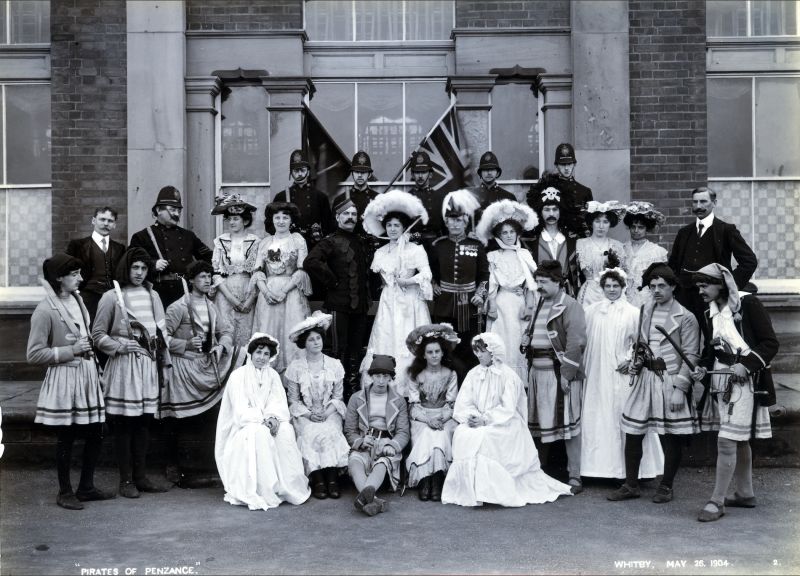 The theatre company at the Pavilion is dated May 26 1904. The piece performed was the comic opera ‘The Pirates of Penzance’. The actors are dressed as pirates mixed with policemen, ladies in Edwardian dresses and hats, other ladies in nightdresses, and men in uniform. An unusual Whitby photograph shows that a theatrical performance of the time used a mixture of contemporary clothes and specially made theatrical costumes. (Courtesy: Whitby Museum…, Photographic Collection, E 857).
The theatre company at the Pavilion is dated May 26 1904. The piece performed was the comic opera ‘The Pirates of Penzance’. The actors are dressed as pirates mixed with policemen, ladies in Edwardian dresses and hats, other ladies in nightdresses, and men in uniform. An unusual Whitby photograph shows that a theatrical performance of the time used a mixture of contemporary clothes and specially made theatrical costumes. (Courtesy: Whitby Museum…, Photographic Collection, E 857).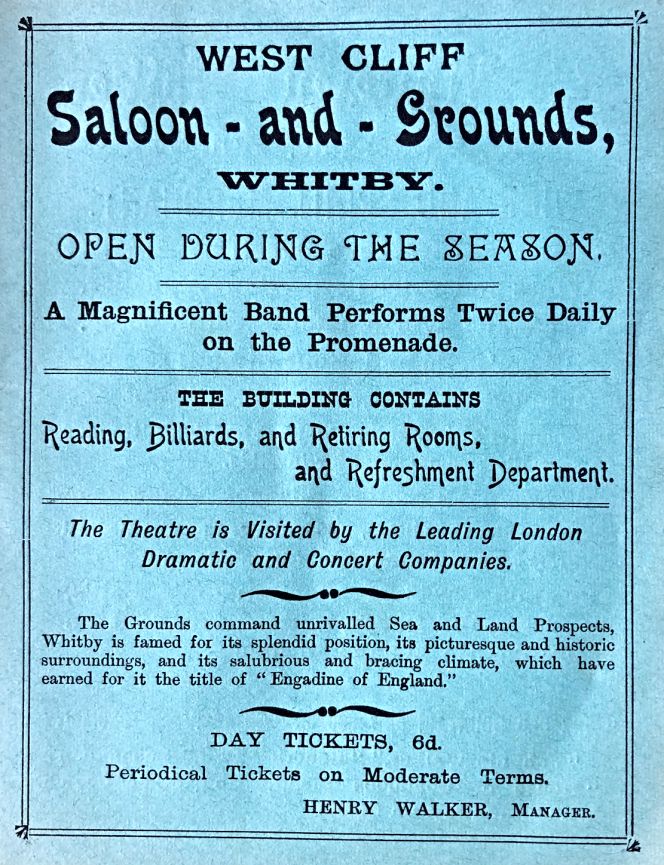 Just one year previously, the same theatre – ‘Visited by the Leading London Dramatic and Concert Companies’- and other amusements at West Cliff – had a full-page advertisement in the Guide to Whitby. ‘The Saloon and Grounds’ was also described in the 1903 Guide as a principal resort for visitors and pleasure seekers to the town in ‘a handsome building facing seaward’. The program included concerts, operatic companies, balls and other entertainments throughout the season. (From: Newton’s Popular Guide…1903).
Just one year previously, the same theatre – ‘Visited by the Leading London Dramatic and Concert Companies’- and other amusements at West Cliff – had a full-page advertisement in the Guide to Whitby. ‘The Saloon and Grounds’ was also described in the 1903 Guide as a principal resort for visitors and pleasure seekers to the town in ‘a handsome building facing seaward’. The program included concerts, operatic companies, balls and other entertainments throughout the season. (From: Newton’s Popular Guide…1903).The Pavilion, built in the 1870s on the cliffside by the sea, was a popular area for theatre, entertainment and relaxing on a warm summer’s day, which is particularly evident via a selection of preserved photographs in the Whitby Museum Photographic Collection, dating around the same time as the entertainment picture and advert above. Another source linked to a local theatre was an informative part of the Reports of Whitby Lit. & Phil. Society in 1970 (Bygones Section), where it is evident that still, at this time, the museum let a local theatre use original Victorian accessories and in return had the possibility to lend even older costumes. In a quote from the Report:
- ‘On loan from the Whitby Amateur Dramatic Society, we have a gentleman’s black velvet breeches suit, entirely hand made, which probably dates from 1830, and in perfect condition: also a sprigged muslin day dress timed with magenta.
- For the recent production by the Whitby Amateur Dramatic Society of the costume play “Miss Letitia”, several small items were lent by the Bygones section including an original carpet bag’.
Overall, the substantial collections of textiles and textile-related implements that the museum houses today were not collected in any quantity till the move to Pannett Park in 1931 (Whitby Literary & Philosophical Society had been founded in 1823), since when they have been added to yearly up to the present. These articles have been catalogued through the years under such headings as ‘Local History ‘, ‘Bygones’, ‘Household bygone section’, ‘Costumes’, ‘Samplers’ and ‘Social History.’ From the 1950s to the 1970s, we can read year by year of well-preserved dresses and other textiles – for the most part, dating from the Victorian age – and usually presented by ladies living locally. Additionally, it is even likely that many of these Victorian garments, between the period of use and up to the donation at the museum, off and on, could have been used for dressing-up or amateur theatre in homes and school plays locally.
From a more general perspective, the theatre became increasingly popular during the 19th century, assisted by the actors’ historical costumes mixed with fashion for that time, modern stage plays or ‘living history’ re-enactment. The dress and social historian Valerie Cumming also emphasised in Understanding Fashion History – in her chapter about the theatrical dress – that it was an advantage if female actors had some dressmaking skills to alter, re-use or make up a suitable garment for one’s performance. Additionally, she gave an interesting example from York in 1826 when the actor Samuel Phelps (1804-78) made purchases of theatrical costumes from a dealer. He acquired: ‘… a pair of russet boots, a pair of sandals, a pair of fleshings, a pair of worsted tights, an old sword, and a few other odds and ends, for thirty shillings’ (quote p. 127). As mentioned earlier, Whitby had had a daily mail-coach service to York since 1823, so this city, with its more extended choice of entertainment, must have been a desirable place to visit for the residents of Whitby. Especially as Whitby only had theatre performances every second winter, according to the local historian George Young in the early 19th century.
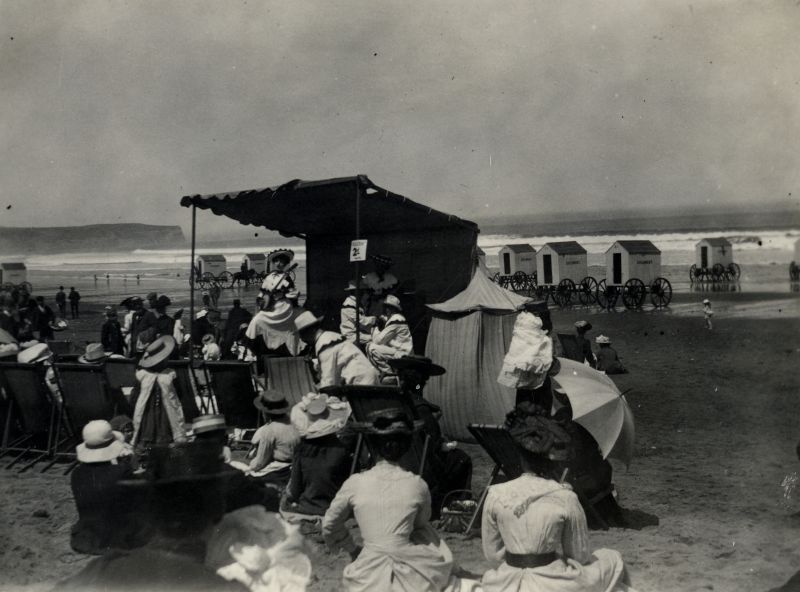 This view of a summer day on the beach on the west side of Whitby illustrates what seem to be mainly summer tourists in light-coloured clothes listening to musical entertainment. Even the woman musician and the two men glimpsed on the stage are dressed entirely in white. To enjoy a day on the shore as a bystander dressed in a delicate white cotton dress was mainly possible for the well-off and middle classes, judging by this and other similar photographs from circa 1905. Even more extensive groups of society could enjoy a summer Sunday at the beach in late Victorian and Edwardian times than in earlier years. (Courtesy: Whitby Museum…, Photographic Collection, C 525).
This view of a summer day on the beach on the west side of Whitby illustrates what seem to be mainly summer tourists in light-coloured clothes listening to musical entertainment. Even the woman musician and the two men glimpsed on the stage are dressed entirely in white. To enjoy a day on the shore as a bystander dressed in a delicate white cotton dress was mainly possible for the well-off and middle classes, judging by this and other similar photographs from circa 1905. Even more extensive groups of society could enjoy a summer Sunday at the beach in late Victorian and Edwardian times than in earlier years. (Courtesy: Whitby Museum…, Photographic Collection, C 525).When the number of visiting holiday-makers increased over the years, a need for entertainment of various kinds also developed, as the seaside photography concert-party photograph from 1905 shows above. A performance of this kind lasted an hour, for which it was possible to hire a deckchair for sixpence or throw oneself down on the sand to enjoy a warm summer day. The many big hats, white blouses, belted waists, simple long skirts and white parasols of the women were the typical seaside fashion at the time. This kind of popular seaside holiday in Whitby with entertainment and people in pretty light-coloured summer clothes and wide hats came to an abrupt end in 1914 with the outbreak of war.
Another event in the open air may be exemplified via the Temperance Society, which had been founded in September 1843; many years later in September 1898, when the society had been in existence for 55 years, they had a parade in the same West Cliff area of the town, documented by the photographer Tom Watson (1863-1957). Such an outdoor event, where hundreds of citizens, men as well as women, attended, gave ample opportunities to study details of clothing and particularly headgear due to a slight bird’s-eye perspective. Similarly, a photograph taken by Frank Meadow Sutcliffe (1853-1941) from the church tower of Whitby Parish church gives a rare opportunity to catch a glimpse of fashionable visitors, in particular, a multitude of hats and umbrellas on a drizzling and smoggy day. The occasion can be dated to 21st September 1898, when the Caedmon Cross was unveiled. This essay will conclude with two further outdoor photographs, which give a multitude of reflections on garments worn by women, men and children in a coastal town like Whitby in the early 20th century.
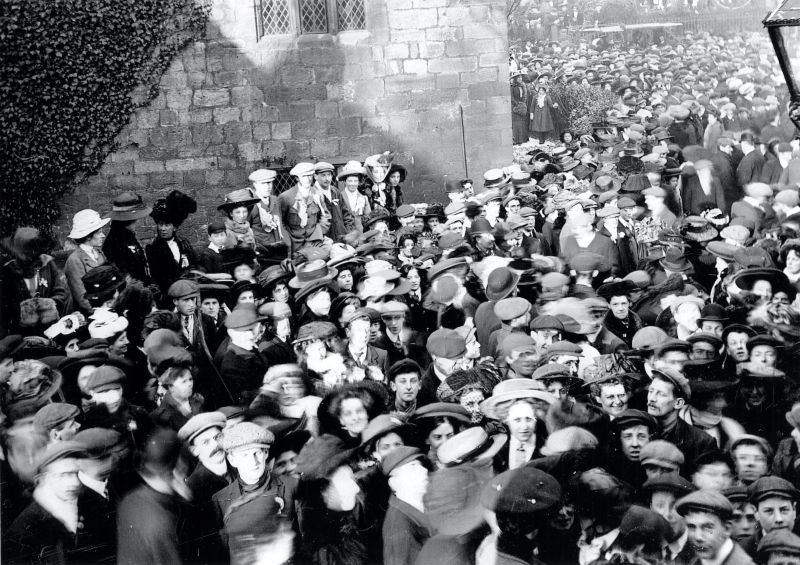 An interesting Whitby photograph from about 1910 titled ‘Awaiting an election announcement in Victoria Square’ shows everyone wearing some kind of outdoor headgear, from the plainest caps for boys to the large, highly decorated female hat styles in vogue at the time. (Courtesy: Whitby Museum…, Photographic Collection, LIB 7704).
An interesting Whitby photograph from about 1910 titled ‘Awaiting an election announcement in Victoria Square’ shows everyone wearing some kind of outdoor headgear, from the plainest caps for boys to the large, highly decorated female hat styles in vogue at the time. (Courtesy: Whitby Museum…, Photographic Collection, LIB 7704).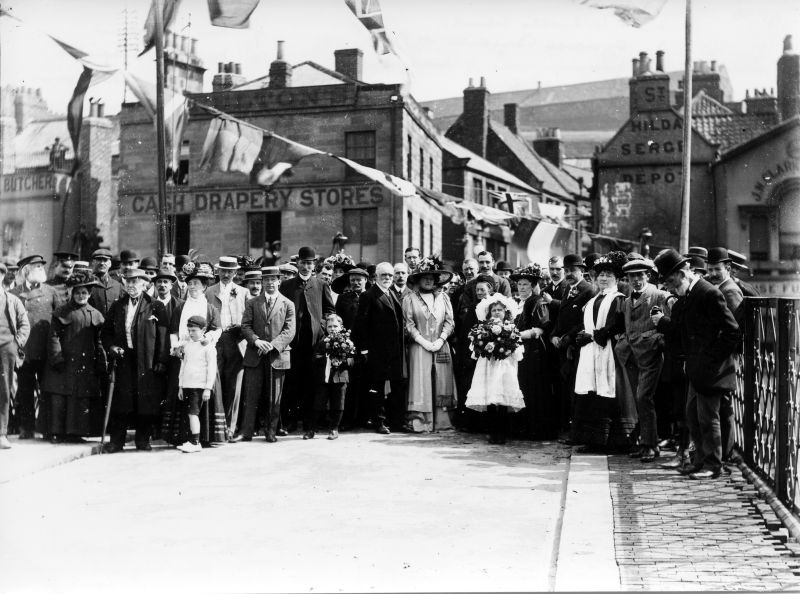 A photograph of the ‘Opening of the Swing Bridge year 1909’ is one illustration among many of the period that shows clearly the cut and style of clothes worn by women, men and children in the first years of the new century. (Courtesy: Whitby Museum…, Photographic Collection, B 711).
A photograph of the ‘Opening of the Swing Bridge year 1909’ is one illustration among many of the period that shows clearly the cut and style of clothes worn by women, men and children in the first years of the new century. (Courtesy: Whitby Museum…, Photographic Collection, B 711).Sources:
- Cumming, Valerie, Understanding Fashion History, London 2004 (pp. 114-129. Theatrical dress…).
- Hansen, Viveka, The Textile History of Whitby 1700-1914 – A lively coastal town between the North Sea and North York Moors’, London & Whitby 2015 (pp. 18-30, 44-46 & 80-82).
- Newton’s Popular Guide to Whitby and the Neighbourhood, Whitby 1903 (Advert & Quotes p. 22).
- Reports of Whitby Lit. & Phil. Society. Vol. VII. Reports 1962-1971 (1970, quote: p.12).
- The Public Catalogue Foundation, Oil Paintings in Public Ownership in North Yorkshire, London 2006 (Whitby Museum, pp. 113-127).
- Whitby Museum (Whitby Lit. & Phil.), Whitby, United Kingdom. Library and Archive. |Photographic Collection. |Picture Collection. | Textile & Costume Collection (In-depth research visits 2006-2011 for my publication published in 2015.
- Young, George, A History of Whitby, Vol. I-II, 1817 (p. 636).
More in Books & Art:
Essays
The iTEXTILIS is a division of The IK Workshop Society – a global and unique forum for all those interested in Natural & Cultural History.
Open Access Essays by Textile Historian Viveka Hansen
Textile historian Viveka Hansen offers a collection of open-access essays, published under Creative Commons licenses and freely available to all. These essays weave together her latest research, previously published monographs, and earlier projects dating back to the late 1980s. Some essays include rare archival material — originally published in other languages — now translated into English for the first time. These texts reveal little-known aspects of textile history, previously accessible mainly to audiences in Northern Europe. Hansen’s work spans a rich range of topics: the global textile trade, material culture, cloth manufacturing, fashion history, natural dyeing techniques, and the fascinating world of early travelling naturalists — notably the “Linnaean network” — all examined through a global historical lens.
Help secure the future of open access at iTEXTILIS essays! Your donation will keep knowledge open, connected, and growing on this textile history resource.
been copied to your clipboard




– a truly European organisation since 1988
Legal issues | Forget me | and much more...
You are welcome to use the information and knowledge from
The IK Workshop Society, as long as you follow a few simple rules.
LEARN MORE & I AGREE







